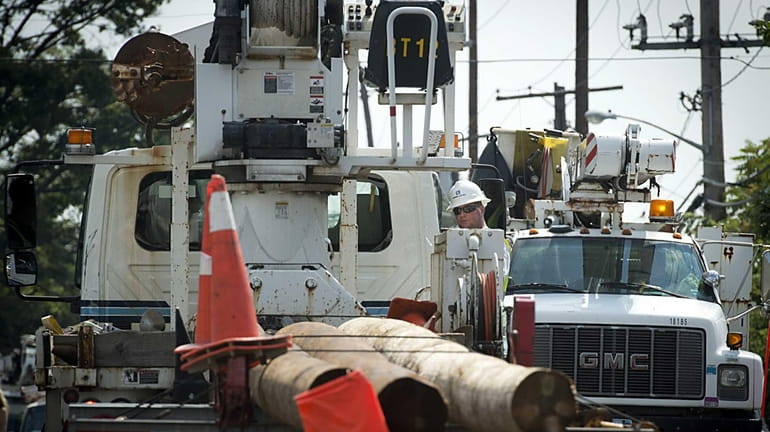LIPA number crunchers struggle with 2014 budget

LIPA and other utility crews work to repair damaged poles and downed lines in Elmont. LIPA has been waiting on about $100 million in insurance payments to cover the cost of repairing 51 substations damaged during Sandy. (Aug. 27, 2013) Credit: Newsday / J. Conrad Williams Jr.
Long Island Power Authority number crunchers have been working overtime to produce a 2014 budget that includes a long list of service improvements and new costs -- no small task given a goal of freezing rates for the next two years, officials said.
While some costs such as staffing and consulting fees are expected to decline as LIPA trims its employee ranks by half and narrows its use of outside companies, those costs are small compared to some new bills LIPA faces as it passes near-total control of the system to PSEG of Newark.
"That's what we're in the throes of doing right now," LIPA chief financial officer Michael Taunton said last week. "We're still seeking to achieve the rate freeze," he said, but stressed that it was a "goal."
Some of LIPA's budget problems may be shored up by money coming in from state and federal grants. Recently, Gov. Andrew M. Cuomo announced that LIPA would receive some $50 million in federal money to help pay for the $31 million outage management system and related storm communication equipment.
LIPA has also been waiting on about $100 million in insurance payments to cover the cost of repairing 51 substations damaged during Sandy. Last week, Cuomo also announced $72 million to harden substations for the next big storm, costs LIPA otherwise would have had to pass on to ratepayers.
LIPA's new contract with PSEG to run the electric grid comes with one of the largest invoices LIPA has seen in its history: a total of $5.1 billion over the next 12 years, LIPA estimated.
The math isn't as simple as $425 million a year because PSEG's service fee increases, from $36.3 million in 2014-15 to $52 million in 2016, and the expanded scope of the contract means LIPA will be paying the New Jersey company considerably more than it has paid National Grid over the past seven years.
Taunton said it's not just the cost of increased commitments to storm hardening and improved service that LIPA must fund. The utility has seen a decline in sales since superstorm Sandy, and so it must base the budget on the assumption that revenue will remain flat or slightly below previous levels.
"A one percent change in sales is a very dramatic number," he said.
He said LIPA is working to prioritize the to-do list handed it by the Department of Public Service in an exhaustive management service audit released in September. LIPA general counsel Lynda Nicolino said LIPA is banking on help from a new Department of Public Service branch on Long Island.
The roughly $400 million total that LIPA will pay PSEG starting next year includes the cost of programs it maintains such as renewable energy and efficiency plans, and the cost of salaries for 1,900 unionized and management workers. There's also a transition cost of $40 million that LIPA will pay over the 12-year contract to cover the expense of passing the torch from National Grid to PSEG.
But there also are wild-card items that could challenge LIPA's ability to keep the delivery charge frozen (the power supply charge fluctuates month to month with fuel bills).
For instance, LIPA next year must begin paying $80 million in costs for superstorm Sandy repairs not covered by federal reimbursement programs. The plan is to pay it over 10 years. LIPA officials said the 2014 budget will be finalized in coming weeks, and trustees must approve it before year's end.
